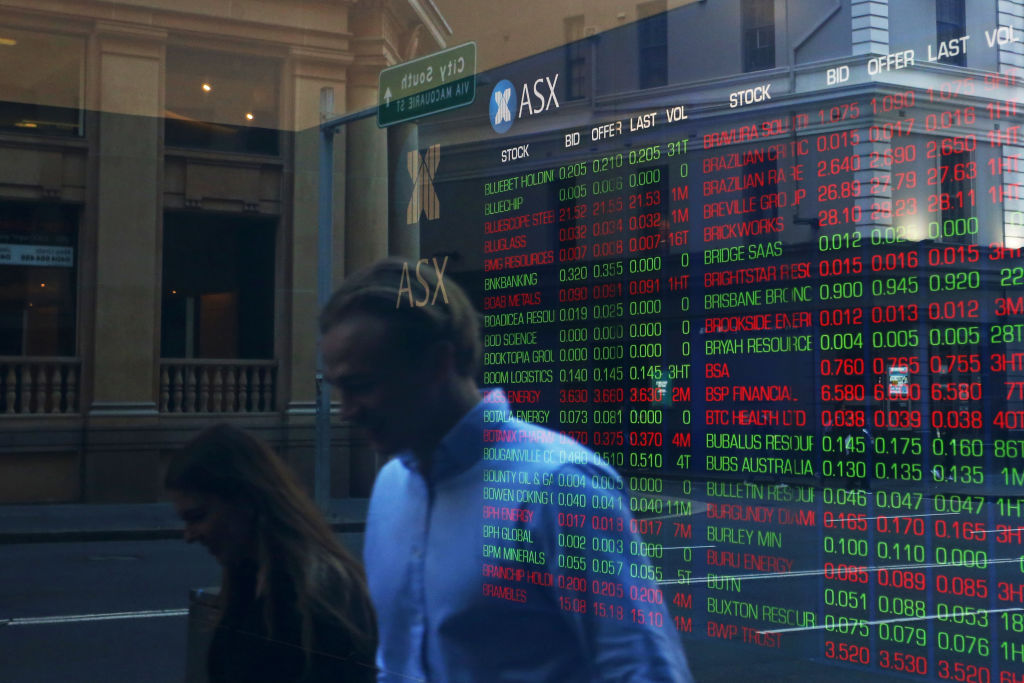ASX shares are ‘vulnerable to further falls’: expert
Investors may still be in for a bumpy ride yet as a leading Australian economist forecasts that more volatility in global markets is likely over the coming months
Investors are nervous and “sensitive to weaker economic data”, with more volatility likely ahead for the Australian share market despite its stabilisation in recent days, says AMP chief economist Dr Shane Oliver. A dramatic global sell-off at the start of the month saw the ASX 200 plunge 465 points or 5.73 percent over two trading sessions, with other share markets around the world also tumbling.
A weak jobs report and manufacturing report out of the United States sparked the sell-off due to fears the world’s biggest economy may be slowing faster than thought and a recession may be imminent. Major ASX 200 companies were caught up in the sell-off, with shares in our biggest technology company, Wisetech, falling 12.58 percent over the two days. ASX 200 bank shares were also hit hard, with NAB shares dropping 8.52 percent and CBA shares shedding 8.35 percent.
Other major fallers included the ASX 200’s largest property stock, Goodman Group, with its share price diving 11.86 percent over the two days. Shares in the market’s biggest retail stock, Wesfarmers, fell by 6.19 percent, and the ASX 200’s biggest energy company, Woodside, lost 5.5 percent. Shares in the ASX 200’s biggest mining company, BHP, slipped 3.25 percent.
Another contributor to the global sell-off was the winding back of the Japanese yen ‘carry trade’. A carry trade is where global investors borrow money in a low-rate currency and invest in other currencies and assets, such as bonds and shares, that offer a higher rate of return. Japan had zero or negative interest rates for almost 14 years before the Bank of Japan raised rates in March to a range of 0–0.1 percent and again last month to 0.25 percent. This prompted investors to begin selling their investments, which are spread across share markets all over the world, to reduce or end their carry trades.
The threat of a recession in the US was somewhat quelled last week when the latest US initial jobless claims report showed the number of workers claiming welfare was lower than expected. Comments from the Bank of Japan’s deputy governor indicating the bank would not raise rates further while markets are unstable also calmed investors’ nerves. As a result, some losses were clawed back. The ASX 200 finished 2.08 percent lower last week, with Japanese shares down 2.5 percent and US shares down 0.04 percent.
Dr Oliver said ASX shares could rebound a little more but they remain “vulnerable to further falls over the next few months”. Dr Oliver said this was due to stretched valuations and a “very high” risk of recession both in Australia and the US. He said there were indications of deteriorating employment in both economies and share markets had not priced this into company valuations.
Dr Oliver added: “… geopolitical risk is high particularly around the US election and the Middle East with a high risk of escalation between Iran and Israel after the assassination of [a] Hamas’ leader in Iran; and we have only just started in the seasonally weak period of August and September which can sometimes extend into October/November in US election years”.
Dr Oliver said the Reserve Bank was “surprisingly hawkish” last week, with Governor Michele Bullock saying the board considered a rate rise at its meeting before deciding to keep rates on hold. She also said a rate cut was unlikely over the next six months. The RBA has also pushed out its expectations on the timing for a return of inflation to its target middle of the 2-3 percent band by six months.
“This hawkishness was a bit surprising given that in the last few months economic growth came in weaker than expected and inflation was broadly in line with RBA forecasts, the RBA’s near-term wage growth forecasts have been revised down and uncertainty regarding growth in China and the US has increased,” Dr Oliver said.
A divide has opened in the tech job market between those with artificial-intelligence skills and everyone else.
A 30-metre masterpiece unveiled in Monaco brings Lamborghini’s supercar drama to the high seas, powered by 7,600 horsepower and unmistakable Italian design.
A divide has opened in the tech job market between those with artificial-intelligence skills and everyone else.
There has rarely, if ever, been so much tech talent available in the job market. Yet many tech companies say good help is hard to find.
What gives?
U.S. colleges more than doubled the number of computer-science degrees awarded from 2013 to 2022, according to federal data. Then came round after round of layoffs at Google, Meta, Amazon, and others.
The Bureau of Labor Statistics predicts businesses will employ 6% fewer computer programmers in 2034 than they did last year.
All of this should, in theory, mean there is an ample supply of eager, capable engineers ready for hire.
But in their feverish pursuit of artificial-intelligence supremacy, employers say there aren’t enough people with the most in-demand skills. The few perceived as AI savants can command multimillion-dollar pay packages. On a second tier of AI savvy, workers can rake in close to $1 million a year .
Landing a job is tough for most everyone else.
Frustrated job seekers contend businesses could expand the AI talent pipeline with a little imagination. The argument is companies should accept that relatively few people have AI-specific experience because the technology is so new. They ought to focus on identifying candidates with transferable skills and let those people learn on the job.
Often, though, companies seem to hold out for dream candidates with deep backgrounds in machine learning. Many AI-related roles go unfilled for weeks or months—or get taken off job boards only to be reposted soon after.
Playing a different game
It is difficult to define what makes an AI all-star, but I’m sorry to report that it’s probably not whatever you’re doing.
Maybe you’re learning how to work more efficiently with the aid of ChatGPT and its robotic brethren. Perhaps you’re taking one of those innumerable AI certificate courses.
You might as well be playing pickup basketball at your local YMCA in hopes of being signed by the Los Angeles Lakers. The AI minds that companies truly covet are almost as rare as professional athletes.
“We’re talking about hundreds of people in the world, at the most,” says Cristóbal Valenzuela, chief executive of Runway, which makes AI image and video tools.
He describes it like this: Picture an AI model as a machine with 1,000 dials. The goal is to train the machine to detect patterns and predict outcomes. To do this, you have to feed it reams of data and know which dials to adjust—and by how much.
The universe of people with the right touch is confined to those with uncanny intuition, genius-level smarts or the foresight (possibly luck) to go into AI many years ago, before it was all the rage.
As a venture-backed startup with about 120 employees, Runway doesn’t necessarily vie with Silicon Valley giants for the AI job market’s version of LeBron James. But when I spoke with Valenzuela recently, his company was advertising base salaries of up to $440,000 for an engineering manager and $490,000 for a director of machine learning.
A job listing like one of these might attract 2,000 applicants in a week, Valenzuela says, and there is a decent chance he won’t pick any of them. A lot of people who claim to be AI literate merely produce “workslop”—generic, low-quality material. He spends a lot of time reading academic journals and browsing GitHub portfolios, and recruiting people whose work impresses him.
In addition to an uncommon skill set, companies trying to win in the hypercompetitive AI arena are scouting for commitment bordering on fanaticism .
Daniel Park is seeking three new members for his nine-person startup. He says he will wait a year or longer if that’s what it takes to fill roles with advertised base salaries of up to $500,000.
He’s looking for “prodigies” willing to work seven days a week. Much of the team lives together in a six-bedroom house in San Francisco.
If this sounds like a lonely existence, Park’s team members may be able to solve their own problem. His company, Pickle, aims to develop personalised AI companions akin to Tony Stark’s Jarvis in “Iron Man.”
Overlooked
James Strawn wasn’t an AI early adopter, and the father of two teenagers doesn’t want to sacrifice his personal life for a job. He is beginning to wonder whether there is still a place for people like him in the tech sector.
He was laid off over the summer after 25 years at Adobe , where he was a senior software quality-assurance engineer. Strawn, 55, started as a contractor and recalls his hiring as a leap of faith by the company.
He had been an artist and graphic designer. The managers who interviewed him figured he could use that background to help make Illustrator and other Adobe software more user-friendly.
Looking for work now, he doesn’t see the same willingness by companies to take a chance on someone whose résumé isn’t a perfect match to the job description. He’s had one interview since his layoff.
“I always thought my years of experience at a high-profile company would at least be enough to get me interviews where I could explain how I could contribute,” says Strawn, who is taking foundational AI courses. “It’s just not like that.”
The trouble for people starting out in AI—whether recent grads or job switchers like Strawn—is that companies see them as a dime a dozen.
“There’s this AI arms race, and the fact of the matter is entry-level people aren’t going to help you win it,” says Matt Massucci, CEO of the tech recruiting firm Hirewell. “There’s this concept of the 10x engineer—the one engineer who can do the work of 10. That’s what companies are really leaning into and paying for.”
He adds that companies can automate some low-level engineering tasks, which frees up more money to throw at high-end talent.
It’s a dynamic that creates a few handsomely paid haves and a lot more have-nots.
BMW has unveiled the Neue Klasse in Munich, marking its biggest investment to date and a new era of electrification, digitalisation and sustainable design.
On October 2, acclaimed chef Dan Arnold will host an exclusive evening, unveiling a Michelin-inspired menu in a rare masterclass of food, storytelling and flavour.


















